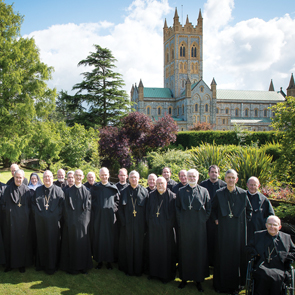One of England’s leading religious orders has turned to its younger members to help address the difficulties posed by ageing communities and scarce vocations.
A forum of 30 monks and nuns of the English Benedictine Congregation (EBC) aged under 55 met last month to galvanise their thoughts, the result of which was passed on to a subsequent meeting of the Extraordinary General Chapter of the order.
The general chapter is made up of abbots, abbesses and delegates from the 13 English Benedictine abbeys, the United States and missions in Peru and Zimbabwe. The EBC itself is the world’s oldest grouping of Benedictine communities and has been a presence in the Church in England and Wales since its foundation in the thirteenth century (bar the Reformation).
The rationale behind asking the younger members for their thoughts lies in the teaching of St Benedict, who said: “The Lord often reveals what is better to the younger.”
Both gatherings took place at Buckfast Abbey, the Benedictine monastery in Devon, on 21-29 July following a decision in 2013 that the discussions should take place to consider challenges facing some of the monasteries.
The forum of younger members made a series of recommendations to the general chapter that have, according to a statement from the EBC, been “warmly received and considered positively”.
In a statement the EBC confirmed that Downside Abbey, in Somerset, the senior house of the order, has just eight resident monks and one postulant. This stands against a backdrop of decline suffered by the EBC, which in 1973 had 506 monks and 136 nuns; by 2013 the figure was 279 monks and 35 nuns.
Ampleforth Abbey, the largest community, has 70 monks although about half of these are over 65. Its former abbots include the late Cardinal Basil Hume, while it currently runs a number of parishes, a prominent independent school and St Benet’s, a Permanent Private Hall of the University of Oxford.
Benedictine communities are renowned for their schools including Downside in Somerset, Ampleforth in North Yorkshire, Worth in west Sussex and St Benedict’s in Ealing, west London. All these schools now have lay headmasters.
The Abbot President Richard Yeo said: “The holding of the general chapter, and involving younger monks and nuns through the forum, is recognition in itself that these are challenging times, that some communities are facing difficulties, and we need, as individual monasteries and as a congregation, to respond.”
He added the challenges were not just about declining numbers but “more about the fact that we living in a complicated global world, and it is only right that we should be looking today at how the English Benedictine Congregation and the monasteries can thrive in that environment in the future”.
The English Benedictines have also said that closer collaboration between the houses is likely to take place in the future. Already novices from across the houses spend a fortnight together once a year and individual monks from one monastery are at times seconded to another monastery to deal with a specific issue.
The forum for younger members also decided against a proposal for abbots to be elected for life and indicated they wanted to maintain the status quo of abbots serving eight-year terms.
Alumni of Benedictine schools include Lord (Chris) Patten, Chancellor of the University of Oxford, and the former Cabinet Secretary Lord Hunt.
And one of the most prominent English-speaking voices at the Second Vatican Council, Bishop Christopher Butler, was a monk of Downside.
Above: Benedictines at Buckfast Abbey




 Loading ...
Loading ...